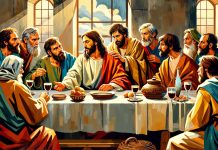Today’s increasingly politically correct and very denotative way of transmitting messages of public interest tends to distort the reception of speeches that have rhetorical and expressive nuances. In this context, how do we evaluate the cryptic nature of Jesus’s words?
The Gospels record Jesus’s discourses in the context of an oral culture similar to ancient culture. By contrast, today, journalistic discourse is prone to a single-use approach to its particular message.
In antiquity, discourse had to be understood, preserved, and perpetuated in posterity. The stylistic requirements for the two types of messages differ enormously. In a very graphic and applied comparison, it would be like the difference between a Martin Luther King Jr. speech and a train station announcement about the next train.
Let us address some controversial statements from Jesus’s discourse
“ Again I tell you, it is easier for a camel to go through the eye of a needle than for someone who is rich to enter the kingdom of God” (Matthew 19:24).
This example seems simple and accessible. The stylistic figures that Jesus uses—comparison and hyperbole—are for didactic purposes. The image he uses is also present in other ancient sources in Jewish literature, and the elements were familiar to Jesus’s listeners.[1]
The meaning is captured by the listeners and is probably easy for us to understand. The projected image has a comic effect resulting from the hyperbolic contrast between the dimensions of the two objects—it creates an impossible and ridiculous picture through its absurdity. This hyperbole wants to show the incompatibility of selfishness and self-service within the Kingdom of God.
“ If you don’t have a sword, sell your cloak and buy one” (Luke 22:36).
In this case, the stylistic language is more difficult to interpret. In this discourse around His arrest, Jesus starts from the concrete meaning and reaches the figurative, symbolic meaning. As on other occasions, Jesus compresses communication, moving from its own meaning to the symbolic meaning of words, in the hope that the disciples will understand that they need their own resources to withstand the coming trial and be prepared for difficulties and opposition.
Jesus’s symbolic language had multiple, latent nuances that could be useful to the disciples in the various contexts of the challenges that followed. But at that moment, the disciples failed to cross the threshold of symbolic understanding, as is evident from the context of the statement, and Jesus refuses to explain what he has to say.
The “sword” has a metaphorical meaning, suggesting equipment and training in the fight against spiritual dangers. The desperate need to be “armed” for these future events is palpable from the suggestion to sell one’s mantle, which, given the local weather, was essential for warming at night.[2]
The first listeners’ difficulty in interpreting what they heard is retained in the narrative, indicating the need to explore the deeper meanings of Jesus’ expression. We will seek to understand the figurative meanings of the “sword” by looking for another example:
“Do not suppose that I have come to bring peace to the earth. I did not come to bring peace, but a sword” (Matthew 10:34).
Here, too, Jesus apparently contradicts His teaching about nonviolence and the love of enemies and family. But He is not contradicting Himself. Instead, He is affirming two ideas by powerful rhetorical means.
First, He says that the gospel sometimes generates conflict because of the profound differences and disagreements that arise between those who accept it and those who do not. In a context where the community was superior to the individual, and faith could not be asserted without risk, confessing that faith presents a significant risk.
Second, the family and its place in society must be redefined in our popular understanding. The blood family is no longer at the top of the hierarchy in establishing moral and eternal landmarks, but the gospel—the love for Jesus—must be primary. Scripture certainly teaches us the importance of family connection, but not by sacrificing faithfulness to Jesus.[3]
The entirety of chapter 10 of the Gospel of Matthew aims to prepare the disciples for the mission given by Christ. After offering assurances, Jesus reveals the reciprocity of the relationship between Him and the disciple in the ‘economy’ of salvation (vv. 32-33) compared to other relationships, which have limitations.
Then, until verse 38, a progressive suite of antitheses unfolds and culminates in a paradox. Relationships with relatives, presented in opposition to the relationship with Jesus, one’s personal priorities over divine priorities, are examined, culminating in the paradoxical statement in v. 39: “Whoever finds their life will lose it, and whoever loses their life for my sake will find it.”
By affirming the stakes of confessing to the dangers of faith in this hyperbolic way, Jesus emphasizes the hierarchy of priorities from the divine perspective, and the final paradox makes the argument unforgettable. The whole rhetorical argument and its construction are vital for understanding the difficult statements in the speech.
Conclusions
Some of Jesus’s controversial statements can be understood in the context of that discourse, by analysing the stylistic figures used in the flow of His argument. Just as a ripple cannot be removed from the pebble that caused it, so Jesus’s statements cannot be taken out of their original context without losing their meaning.
Aware that His discourse remains in memory and posterity, through the stylistic figures used—metaphor, hyperbole, paradox, comparison, allegory and other stylistic and rhetorical procedures—Jesus encrypts the explanation instead of clarifying it. The cipher has the role of polarizing the meaning of His initial statements and ensuring their retention in the memory of the listeners.
The text should be read with patience, curiosity, and interest in its deep meanings.
Often, at the end of His discourses, he offers an explanation, but this usually refers to the symbolic elements, and not deconstructively to the central idea he conveys (the evangelists, however, also provide examples that help the process of deciphering these discursive processes—see the parable of the sower explained in Matthew 13:1-23). Preserving the symbolic meanings in the discourse ensures, in the context, attractiveness, openness to a diverse audience and the resistance at the time of the message.
The text should be read with patience, curiosity, and interest in its deep meanings. The problem of the modern reader is that for the sake of increasing efficiency, superficiality in receiving information has also been invested with high value, because people now expect to have the easiest possible access to any information. This process has diluted the idea of discourse and has devalued the meaningful speech. Jesus did the exact opposite, concentrating ideas in a few words, dependent on the listener’s participation, with germinal meanings that generate re-contextualizable applications.
A series of parables from Jesus speaks exactly about this—about the way in which the message about the Kingdom of God is taken onboard by the one who listens to or reads the message (the parable of the pearl, the parable of the sower, etc.). This process presupposes that today’s reader assumes a disciple’s role—which the initial listener also had—by immersing them in the context and in the discourse in order to approximate the applied meanings of the text.
Laurenţiu Nistor believes that, in order to understand biblical messages, it is essential for the reader to take into account the literary dimension of the text being interpreted.




















